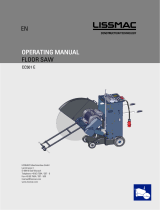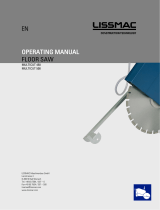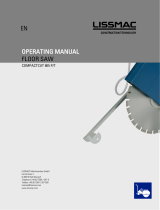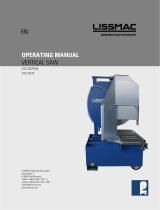Page is loading ...

1/107
OPERATING MANUAL
FLOOR SAW
MULTICUT 550 GH
MULTICUT 600 G / SG
LISSMAC Maschinenbau GmbH
Lanzstrasse 4
D-88410 Bad Wurzach
Telefon +49 (0) 7564 / 307 - 0
Telefax +49 (0) 7564 / 307 - 500
lissmac@lissmac.com
www.lissmac.com
EN

2/107

3/107
Legal notice This operating manual is valid for:
LISSMAC floor saw
MULTICUT 550 G / GH
MULTICUT 600 G / SG
Manufacturer:
LISSMAC Maschinenbau GmbH
Lanzstrasse 4
D - 88410 Bad Wurzach
Phone: +49 (0) 7564 / 307 – 0
Fax: +49 (0) 7564 / 307 – 500
lissmac@lissmac.com
www.lissmac.com
Original operating manual
Issue date: 08-2020
Save this manual for future reference!
Distribution and duplication This operating manual must not be disclosed or reproduced in any form or its contents used without
written permission to do so.
Breaches will result in claims for compensation. All rights reserved in the event of patent, registered
design or design patent registration.

4/107
BASIC SAFETY INFORMATION
Warning notes and symbols in this manual
SIGNAL WORD
Type and source of danger
Consequence of non-compliance.
Action to avert the danger
The signal word after the hazard symbol indicates the level of danger:
DANGER
This signal word indicates an extremely dangerous situation. If the situation is not avoided,
the consequence will be fatal injuries. The hazard symbol may give details of the danger.
WARNING
This signal word indicates a potentially dangerous situation. If the situation is not avoided, the
consequence may be fatal or serious injuries.
The hazard symbol may give details of the danger.
CAUTION
This signal word indicates a dangerous situation. If the situation is not avoided, the
consequence will be medium and minor injuries. The hazard symbol may give details of the
danger.
NOTICE
This signal word indicates a situation which may present a danger for property. If the situation
is not avoided, the consequence will be property damage. This signal word is shown without a
hazard symbol.
Important information is marked with an "i".
Request for the operator to take action:
The specified sequence of the action steps facilitates the proper and safe handling of the
machine.
Instructions for the operator
The warning notes contained are not exhaustive.
Lissmac cannot foresee every potential hazard.
Reasonable safety rules and precautions must be followed as with any other machine,
in terms of working methodology and operation.

5/107
The following warning signs and safety notes are used:
Read the operating manual
Wear hearing protection
Wear safety goggles
Wear work gloves
Wear protective helmet
Wear dust mask
Wear suitable work clothes and wash regularly
/ Attachment point for crane transports
Remove the ignition key before working on the unit
Engage or release parking break only at standstill
Cutting hazard at the rotating tool
Wait for all parts to stop
Do not relocate the machine with rotating tool
Extremely flammable fuel vapors
Warning of crushing hazard.
Ejected parts hazard
Warning of suspended loads

6/107
Burn hazard
Suffocation hazard from of toxic exhaust fumes
Battery acid hazard
Explosion hazard
Entanglement hazard at belt drive
Cut hazard at rotating tool
Crush hazard
Electrocution hazard from buried power lines
Do not use high pressure cleaners
Use by unauthorized persons not permitted
No smoking
Hazardous material: fine silica dust
Do not work on machine while the tool is spinning
Instruction for damage prevention.
Lashing point for vehicle transport
Only transport in an upright position
Sound power level of the machine
Visual check

7/107
OPERATING MANUAL
Preface This operating manual is designed to make it easy to familiarize yourself with the machine and use it
for its intended purpose.
The operating manual contains important information on how to operate the machine safely, properly
and economically. Compliance with it will help to avoid dangers, repair costs and downtimes and
increase the reliability and service life of the machine.
The operating manual is to be supplemented by instructions due to existing national regulations for
accident prevention and environmental protection.
The operating manual must be available at the location of the machine at all times.
The operating manual must be read and used by everybody who undertakes work on the machine, for
example:
Operation, including setting, troubleshooting whilst operating, removal of production waste,
care, disposal of media and consumables
Maintenance (servicing, inspection and repair) and/or
Transport
In addition to the operating manual and the binding regulations for accident prevention which apply in
the user's country and at the place of use, the acknowledged rules for safe and correct working
practice must also be observed.
Tools required A tool in the form of a saw blade is required for operating the floor saw. These tools can be purchased
from the manufacturer.
Further documents In addition to this operating manual, further documentations from the respective manufacturer of
individual components of the machine are available:
Internal combustion engine operating manual
LISSMAC does not assume responsibility or liability regarding correctness and completeness of third-
party documentation.
Changes and reservations We have taken every effort to ensure that this operating manual is correct and up to date. To keep our
technological lead over our competitors, it may be necessary to make modifications to the product and
its operation without prior notice. We cannot accept any liability for faults, failures and resulting
damage.
Target group These operating instructions are aimed at semi-skilled and trained personnel in the fields of structural
mechanics, concrete cutting technology, road construction, and civil engineering.

8/107
Notes:

9/107
Table of contents
1. Features & Benefits ........................................................................................................ 11
2. General safety notes ...................................................................................................... 12
2.1. Principle of intended use .................................................................................................12
2.2. Organizational measures .................................................................................................13
2.3. Choice of personnel and - qualification; fundamental obligations ..................................14
2.4. Safety notes regarding the operating phases ..................................................................14
2.5. Note relating to special types of danger .........................................................................16
2.6. Transport .........................................................................................................................17
2.7. Packaging and storage ....................................................................................................18
2.8. Environmental protection ................................................................................................18
2.9. Waste disposal ................................................................................................................18
3. Device description ......................................................................................................... 19
3.1. Designation of machine parts ..........................................................................................19
3.2. Technical specifications ..................................................................................................20
3.3. Sound power level ...........................................................................................................21
3.4. Exhaust fumes .................................................................................................................21
3.5. Hand-Arm Vibration .........................................................................................................22
4. Comissioning .................................................................................................................. 23
4.1. Consumables ...................................................................................................................23
4.2. Tools (saw blade) ............................................................................................................24
4.3. Water pump.....................................................................................................................25
4.4. Refueling .........................................................................................................................26
4.5. Saw blade installation / change (tool) .............................................................................27
4.6. Checking v-belt tension ...................................................................................................29
4.7. Replacing and tensioning v-belts ....................................................................................30
5. Transport......................................................................................................................... 33
5.1. Transport position ...........................................................................................................33
5.2. Relocating by crane .........................................................................................................34
5.3. Tie down for transport .....................................................................................................35
6. Control Desk ................................................................................................................... 36
6.1. Multifunction display .......................................................................................................37
7. Operation ........................................................................................................................ 39
7.1. Safety ..............................................................................................................................39
7.2. Parking lock .....................................................................................................................41
7.3. Start preparations ...........................................................................................................42
7.4. Weight plates (optional) ..................................................................................................42
7.5. Adjusting lowering speed of saw arm .............................................................................43
7.6. Adjusting the handlebars ................................................................................................43
7.7. Gear selection .................................................................................................................44
7.8. Switching from Up-cut to down-cut.................................................................................45
7.9. Engine starting and stopping ...........................................................................................46
7.10. Toe in adjustment ..........................................................................................................47
7.11. Adjusting the cutting depth stop ...................................................................................47
7.12. Cutting operation ...........................................................................................................48
7.13. Maneuvering the floor saw ...........................................................................................50
7.14. Floor saw shut-down .....................................................................................................51
7.15. Conversion from left- to right-cutting ............................................................................52
7.16. Service compartment .....................................................................................................53
7.17. Hydraulic unit (Option SGH) ..........................................................................................54
7.21. Draining gearbox cooling water ....................................................................................57
7.22. Cleaning the water pump ..............................................................................................57
7.23. Checking engine oil level ...............................................................................................58
7.24. Cutting with open blade guard ......................................................................................59
8. Maintenance .................................................................................................................. 60
8.1. Service .............................................................................................................................60
8.2. Tensioning the drive chain ..............................................................................................61
8.3. Changing engine oil .........................................................................................................62
8.4. Grease points ..................................................................................................................63
8.5. Transaxle oil change ........................................................................................................64
8.6. Troubleshooting ...............................................................................................................67
8.7. Torque values for screw connections ..............................................................................68

10/107
8.8. Maintenance plan ...........................................................................................................69
9. Tools ................................................................................................................................ 70
10. Warranty ....................................................................................................................... 71
11. Circuit diagram ............................................................................................................. 73
12. APPENDIX A: ERROR CODE LIST HATZ ....................................................................... 77

11/107
1.
FEATURES & BENEFITS
The practical requirements of professional use were incorporated in the design of this powerhouse.
This professional heavy duty Diesel-powered machine impresses witch outstanding price-performance
ratio, rugged design and easy operation.
Optimum power transmission by high-performance v-belt drive
Warp resistant sheet metal design
Compact and well-balanced chassis for easy maneuvering
Extremely low center of gravity for precise cuts
Very good straight-cutting properties due to tunable rear axle
Electro-hydraulically controlled saw blade lift
Height adjustable handlebars
Hinged split blade guard for near-wall cuts comes as standard
Fast left- to-right cut conversion
Easy access to maintenance components (Air filter, battery, oil reservoir and fuel filter)
Parking lock, operating hours counter and free-wheeling come as standard
Option SG
(3-speed gear box)
Option GH
(2-speed gear box with hydraulic system)
Option G
(2-speed gear box)

12/107
2.
GENERAL SAFETY NOTES
2.1. Principle of intended use
The manufacturer and supplier does not assume any liability in case of incorrect or unintended use.
The machine must not be modified by anybody other than the manufacturer. Changes due to
attachments or conversions on the floor saw require the written approval of the manufacturer.
The machine is built according to the state of the art and the recognized safety-related rules.
Nevertheless its use may result in dangers of injury and death of the user or third parties or adverse
effects to the machine and other property.
The machine must only be used if it is in technically perfect condition and for its intended use, with an
awareness of safety and potential dangers and as set out in the operating manual. In particular, faults
which may adversely affect its safety must be rectified immediately.
Intended use The LISSMAC floor saw belongs to the floor cutting-off machines and is designed exclusively for wet-
cutting joints in concrete or asphalt. The cutting requires a tool in form of a diamond saw blade. The
floor saw may only be operated by one person. The operator must remain behind the handlebars as
long as the machine is running. Any other use above and beyond is considered unintended use.
Intended use also includes compliance with the operating manual and compliance with the inspection
and maintenance manual.
Unintended use Foreseeable misuse / unintended use:
Cutting without blade guard
Cutting without water
Cutting on steep slopes
The cutting of narrow radii
Cutting wood, plastics or metal
(except for reinforced concrete)
Design modifications which alter the safety or design type of the floor saw

13/107
2.2. Organizational measures
This operating manual must be kept within easy reach for everyone at the place of use.
Supplements to the operating manual include general statutory and other binding regulations for
preventing accidents and protecting the environment and must be obeyed.
These duties may also relate, for example, to handling hazardous substances or wearing personal
protective equipment or road traffic regulations.
The personnel assigned with activities at the machine must have read and understand the operating
manual before starting work, and here particularly the chapter safety notes. This particularly applies
to personnel who only work on the machine occasionally, for example setting and maintenance
personnel.
Regularly check that the procedures used by the personnel are safe and show an awareness of the
dangers and that they are following the instructions in the operating manual.
Always use the required and prescribed personal protective equipment.
Observe all safety and danger notes at the floor saw and keep them in readable condition. Replace
any damaged or illegible safety information and warnings.
With safety-related changes of the machine or its operational behavior, shut the machine down
immediately and mark it accordingly. Report the fault to the responsible body/person.
Do not make any changes, by attachment or conversions without written permission of the
manufacturer. The instructions provided by the tool manufacturer must be given due consideration.
Use only checked original spare parts of the manufacturer.
Adhere to prescribed periods for inspection or those specified in the operating manual.
For the implementation of maintenance measures, workshop equipment appropriate for the work is
absolutely necessary.
Machines with internal combustion engines must not be used in closed rooms.
Always obtain detailed information on underground cables in the cutting area and take appropriate
precautions before cutting.

14/107
2.3. Choice of personnel and - qualification; fundamental obligations
Operators must be aged 18 or above and they must be mentally and physically capable of operating
the floor saw. All persons must be instructed in the operation and be expressly assigned by the
employer with the operation of the floor saw.
Specify the responsibilities of the personnel for operating, setting up, maintenance and repairs.
Ensure that only authorized personnel works on the machine.
The operator must wear personal protective equipment such as safety shoes, gloves, safety goggles
and hearing protection, which comply with the safety regulations.
Expel persons not working with the machine from the work area. Cordon off the working area if
necessary.
The operator must ensure with all movements of the floor saw that he does not endanger himself and
other persons. All obstructions which hinder the work procedure or the implementation of the machine
must be cleared at the place of work.
Work on the electrical equipment on the machine may only be carried out by a qualified electrician or
by trained personnel under the management and supervision of a qualified electrician and in
compliance with the electronic regulations.
The operator must be named as the person responsible for traffic-related regulations and make it
possible for him to reject unsafe instructions by third parties.
Only allow personnel being trained, instructed or those completing an apprenticeship to work on the
machine under the constant supervision of an experienced person.
2.4. Safety notes regarding the operating phases
2.4.1. Transport, assembly and installation
Transport, set-up and installation on/with the floor saw must only be carried out in transport position.
The floor saw must be secured against rolling away.
Transport, set-up and installation on/with the floor saw must only be carried out with the saw blade
removed and the motor switched off.
Use a crane to load and unload the floor saw, taking into account the maximum operating weight of
the machine.
Transport may only take place, if all parts on the machine are secured and falling off of individual
parts is impossible.

15/107
2.4.2. Commissioning
When fitting the saw blade, protect your hands from sharp edges.
Make sure the aggregate surface has the required load-bearing capacity. All obstacles must be
removed from the cutting area and good lighting must be provided.
Visual check of the entire floor saw for any damage and defects. Separate check of the protective
devices.
Supply water for saw blade cooling.
Smoking is prohibited when refueling the internal combustion engine.
Particular care should be taken during refueling. Engine parts that became hot during operation pose a
fire hazard.
Fuel must only be stored in approved containers.
No rotating tool, whose maximum speed is lower than the rated speed of the machine, must be used.
Defective or broken tools must be replaced immediately.
2.4.3. Operation
Do not use any unsafe method of working.
Take measures to ensure that the floor saw is only used if it is safe and in functional condition.
Check the floor saw at least once per shift for external signs of damage and defects. Notify the
responsible place/person immediately when changes have occurred (including the operational
behavior). If necessary, shut down the machine immediately and secure it to prevent it being switched
on again.
If the floor saw malfunctions, shut it down immediately and secure it. Have faults corrected
immediately. Electrical installation work may only be carried out by trained electrical personnel.
Only use suitable and checked tools.
To protect against acceleration, the depth adjustment of the saw blade must be moved slowly and in
steps into the ground. Any contact with the rotating tool must be avoided. Keep a safety distance of
1.5m to the saw blade.
Cutting without the blade guard or drive belt cover is prohibited.
The operator must be protected from rotating parts.

16/107
2.4.4. Maneuvering the floor saw
The floor saw may only be relocated when the saw blade is standing still.
Before leaving the operating position on the floor saw, the internal combustion engine must be
switched off and the saw blade must be standing still.
A rotating saw blade poses a serious cut hazard.
2.4.5. Special work while using the machine
Observe the adjustment, maintenance and inspection work and intervals specified in this operating
manual including the details for replacing parts/ parts of the equipment. These activities may only be
accomplished by authorized technical personnel.
When the floor saw has been shut down completely for maintenance and repair work, it must be
secured and marked to prevent it from accidental activation.
Before cleaning, cover and seal all openings, into which no cleaning agent may penetrate for safety
and/or function reasons. Electric motors, switches and plug connectors are at particular risk. Remove
the covers/masking tape completely after finishing the cleaning work.
Always retighten all screw connections loosened during maintenance and repair work.
If the disassembly of safety devices is necessary for setup, maintenance and repair, they are to be
reassembled and checked immediately after conclusion of maintenance or repair work.
Never use a rotating tool, with a maximum speed rating lower than the rated speed of the machine.
2.5. Note relating to special types of danger
2.5.1. Dangers for the operator from the machine
Before leaving the operating position on the floor saw, the internal combustion engine must be
switched off and the saw blade must be stationary.
The internal combustion engine of the floor saw must only be used as intended:
Propel the floor saw and drive the saw blade.
The outlet of the exhaust pipe must always point away from the operator. Do not inhale exhaust fumes.
The exhaust pipe gets hot during operation. Avoid contact and wear personal protective equipment.

17/107
2.5.2. Electrical Energy
Only use original fuses with the prescribed rating. The floor saw must be switched off immediately in
the event of faults. Electrical work may only be carried out by certified and qualified technical
personnel.
The electrical equipment of a machine must be inspected/checked at regular intervals. Defects such
as loose connections and damage cables must be rectified immediately. The machine must be tagged-
out to prevent accidental startup.
2.5.3. Dust
With work in confined spaces, observe existing national regulations, if necessary.
To prevent airborne dust and provide cooling during cutting, the saw blade must be continuously
sprayed with water. Dry cutting is prohibited. Do not eat, drink or smoke in the work area.
2.5.4. Noise
See section 3.3
2.5.5. Exhaust fumes
Machines with internal combustion engine must not be operated indoors or in confined spaces.
2.6. Transport
Lifting gear of sufficient load-bearing capacity must be used when transferring by crane. Check lifting
gear beforehand for any damage.
Appoint a capable signalperson for the lifting operation.
Only lift the floor saw as described in the operating manual using lifting gear.
Only use a suitable transport vehicle with an adequate load-bearing capacity.
Secure the machine properly in compliance with the regulations. Use suitable lashing points.
The floor saw drive must be switched off even for a minor relocation.

18/107
2.7. Packaging and storage
In order to ensure sufficient protection during dispatch and transport, the machine and its components
were carefully packed. The machine should be checked for damage upon receipt. The machine's
packaging consists of recyclable materials. Please separately collect the different materials and place
them in the appropriate containers for recycling.
Do not start the machine if it is damaged. Damaged cables and plug connectors also pose a safety risk
and must not be used. Contact the manufacturer immediately for repair.
If the machine is not operated immediately after unpacking, it must be protected against humidity and
dirt.
2.8. Environmental protection
Packaging material, cleaning products, used or residual media and unpacked wearing parts such as drive
belts or engine oil must be recycled in accordance with the national environmental protection
regulations in force at the place of use.
2.9. Waste disposal
When the device reaches its end of life, particularly if it starts to malfunction, render it inoperable.
Dispose of the device according to the national environmental regulations. Electrical waste may not be
disposed of together with household waste. Deposit the end-of-life device at a central waste collection
center.

19/107
3.
DEVICE DESCRIPTION
3.1. Designation of machine parts
Pos. 1 Handle bars
Pos. 2 Emergency Stop button
Pos. 3 Air filter
Pos. 4 Lifting eye
Pos. 5 Diesel engine
Pos. 6 3-speed-gearbox (*SG option)
Pos. 7 Pointer
Pos. 8 Blade guard
Pos. 9 Chassis
Pos. 10 Drive axis (Hydrostat)
Pos. 11 Water pump with ball valve
2 3 4 5
7
9
10
11
1
6*
8

20/107
3.2. Technical specifications
MULTICUT 550 GH MULTICUT 600 G / SG
Max. cutting depth 415 mm (16.3 in) 515 mm (20.2 in)
Max. saw blade diameter 1000 mm (39.4 in) 1200 mm (47.2 in)
Saw blade arbor 35 mm (6x M12 –TK 120 mm) 25,4 or 35 mm (6x M12 –TK 120 mm)
Blade flange Ø 150 mm
Nominal speed 1. gear 970 1/min (1550 1/min) 970 1/min (1550 1/min) 950 1/min
Nominal speed 2. gear 1550 1/min (2500 1/min) 1550 1/min (2500 1/min) 1620 1/min
Nominal speed 3. gear - - 2450 1/min
Engine HATZ 4-Cylinder
Turbodiesel / EU97/68 IIIA
HATZ 4-Cylinder
Turbodiesel / EU97/68 IIIB & EPA Tier IV
Power (kW/PS) 34 kW / 46,2 PS (45,6 HP) 55 kW / 74,8 PS (73,7 HP)
Fuel type Diesel
Fuel tank size 32 Liter (8.4 gal)
Forward drive speed Hydrostat stepless 0-50 m/min
Reverse drive speed Hydrostat stepless 0-25 m/min
Saw blade lifting mechanism Electro-hydraulic
Saw blade drive V-belt
Weight 950 kg ( 2095 lbs) 930 kg (2050 lbs) 1070 kg (2360 lbs)
Length / Width / Height 1995 / 1030 / 1720
Option GH
(2-speed gear box with hydraulic system)
Option G
(2-speed – requires changing belt setup)
Option SG
(3-speed gear box)
/











